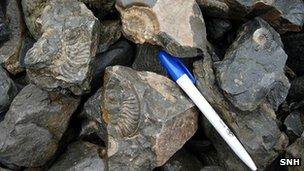Rock drilling 'threatens' Scotland's geology
- Published

Scotland's geology is under threat, SNH's Colin MacFadyen said
Irresponsible drilling of holes into rocks to extract samples threaten to "annihilate" geological features in Scotland, a public body has warned.
Rock coring is done for research of rocks' chemical make up and investigations into how the earth's magnetic field has changed.
When carried out properly, the visual impact is minimal.
However, Scottish Natural Heritage (SNH) said there was growing concern about poor practice at sensitive sites.
<link> <caption>Writing in Geoscientist Online</caption> <altText>Link to Geoscientist Online article</altText> <url href="http://www.geolsoc.org.uk/page12050.html" platform="highweb"/> </link> , SNH geologist Colin MacFadyen said guidance set out in the 1989 Code of Conduct for Rock Coring and also the Scottish Core Code were being ignored.
He said examples of irresponsible drilling included holes drilled into the Sandwick Fish Bed near Stromness, on Orkney.
In the Geological Society's magazine, Mr MacFadyen said: "Worryingly, there are reports from around the world, including one from Scotland, of small scale geological structures not only being defaced, but having been annihilated by coring.
"It is not just geoscientists who are becoming alarmed at the level of irresponsible core sampling, as the cumulative effects of this otherwise efficient sampling method are becoming increasingly apparent to even the most casual observers.
"Irresponsible coring is tarnishing the reputation of geological science as well as damaging exposure, with the general public experiencing defaced outcrop in every setting imaginable - remote beaches and islands, mountain tops, and, lamentably, classic geological sections within statutory protected areas."
Mr MacFadyen's concerns add to previous warnings about the condition of Scotland's geology, fossils and soils.
Last year, tonnes of rock were disturbed at a Jurassic site on Skye in what was described as one of Scotland's most reckless acts of fossil collecting.
SNH said rock was dug away from cliffs near Bearreraig Bay in an apparent organised search for valuable specimens.

Fossils were found smashed on Skye in 2011
Dinosaur footprints have also been removed from Valtos, another location on the island.
Skye is a key dinosaur fossil site in Scotland.
Bearreraig Bay, north of Portree, is within a Site of Special Scientific Interest (SSSI). A crowbar was suspected to have been used to prise away some of the rock.
The State of Scotland's Soils, a report published last year, suggested planning authorities should better understand the role of soils in storing carbon and do more to protect prime farm land.
The document's contributors included public agencies and scientists.
Soils support agricultural businesses worth £700m to the Scottish economy, according to the report.
However, it said the use of increasingly heavy farm machinery and how they compact soils posed a potential threat that was not fully understood in Scotland.
Other key threats to the quality of soils identified in the report included the effects of climate change.
Rainfall and temperatures influence the richness of organic matters - such as plants - in soils, the report said.
- Published17 April 2012
- Published18 November 2011
- Published3 May 2011
- Published30 March 2011